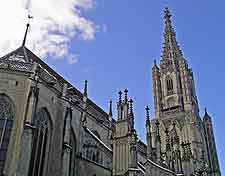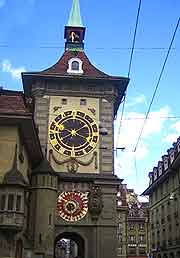Berne History Facts and Timeline
(Berne, Switzerland)

The beginnings of Berne are rather vague and little is known of the capital's most distant history. Within the city centre, there have been no archaeological discoveries unearthed before the 1300s, although evidence suggests that a fortified Roman administrative centre was once located close by, in the Engehalbinsel area.
During the early part of the Middle Ages, the outlying neighbourhood of Bumpliz was home to a thriving settlement, just a couple of miles away from the heart of the city. The actual origins of the name Berne are uncertain, with many believing that the city is named after a 'bear' hunted by founder Berchtold V, Duke of Zahringen. Others think that the city was simply named after
Verona in
Italy, which was referred to as Bern by the Germans.
In the 1980s, an important discovery was made, when the now famous 'Berne zinc table' was found, complete with ancient Gaulish inscriptions. The tablet dates from Roman Gaul and is dedicated to Gallo-Roman god Gobannus. It suggests that the city's name derives from Celtic times, when it was perhaps named 'Berna', meaning 'cleft'. Wherever the name came from, the city has chosen to adopt a stylised black bear as its symbol and this has appeared on its coat of arms for roughly eight centuries.
Medieval Times
Following the demise of the Roman Empire, a number of small settlements remained around the vicinity, with one side of the Bremgarten Woods being used as a burial ground in the 6th century. Further graves have been found around the Rosenbuhl and Weissenbuhl areas, believed to date from the 7th century.
The westerly district of Bumpliz-Oberbottigen featured a growing settlement between the 7th century and the 10th century, complete with a church and fortifications constructed from wood. However, history books generally state that Berne was officially founded in 1191, when the Nydegg Castle was built (later demolished in the 13th century). It became a Free Imperial City within less than three decades, with more than 500 inhabitants. The city soon elected its own mayor and was an important part of the Holy Roman Empire, and by 1300, Berne boasted a population exceeding 3,000 people.
Development, Expansion and Battles
A period of steady growth followed during the 14th century and it was not long before Berne began to experience conflict with nearby Fribourg, located roughly 35 km / 22 miles to the south-west. In 1339, Fribourg and its feudal lords raised an army of more than 15,000 and attacked the city. A siege began, with the suburb town of Laupen being the first in their sights. The Bernese retaliated and together with their allies from Oberhasli, Schwyz, Simmental, Unterwalden and Weissenburg, they fought back. Whilst clearly outnumbered, they fought strongly and courageously, and Berne was soon victorious in its first significant battle.
With a newfound confidence and strength, Berne soon recovered from its battle scars and began to plan expansion in a big way. Following a damaging fire in 1405, many of the wooden houses were rebuilt, although this time incorporated sandstone, creating the character of Old Town Berne. Since there were no notable trading routes in the area, farming and agriculture became a mainstay of the residents. A tanner was established and leather goods were soon being exported.
The canton of Aargau was overthrown and conquered in 1415, followed by the canton of Vaud in 1536 and various other surrounding territories. It was not long before Berne had become the biggest and most important city-state to be located on the northern side of the Alps.

Wealth and the Aristocracy
Amongst the residents of Berne, a number stood out as being especially wealthy and these families soon took on the role of the aristocracy. A government was subsequently formed and trade with Europe strengthened. By the 16th century, guilds had appeared and the city was beginning to produce its famous Bernese glass paintings, which were extremely popular.
Modern Times in the City
The French Revolutionary Wars of the late 18th century took their toll on Berne, with troops soon occupying the city and destroying historic boundaries, although these were reinstated after their departure, at the time of the Helvetic Republic's abolition in 1803. By now, Berne's population was in the region of 12,000 and growing by the day, topping 60,000 just one century later. Switzerland remained completely neutral during the First World War (1914 to 1918) and when this ended, the city's population was close to 100,000.
When the Second World War (1939 to 1945) arrived, Switzerland was soon encircled by fascist troops from
Austria,
Germany and also Italy. Whilst it continued to remain neutral, this was a tough time in Berne history. Reluctant trade and cooperation with Hitler was necessary at times, just to survive this difficult period.
The city is currently called home by approximately 140,000 people and has plenty to offer visitors looking for an insight into its history. Now a World Heritage Site, the Old Town is certainly the place to begin your exploration, with its famous 13th-century Zytglogge clock tower being worth looking out for. The Rosengarten offers great views of the Old Town, while the city's Historical Museum (Bernisches Historisches Museum) contains many interesting Swiss treasures from its bygone days.
 The beginnings of Berne are rather vague and little is known of the capital's most distant history. Within the city centre, there have been no archaeological discoveries unearthed before the 1300s, although evidence suggests that a fortified Roman administrative centre was once located close by, in the Engehalbinsel area.
The beginnings of Berne are rather vague and little is known of the capital's most distant history. Within the city centre, there have been no archaeological discoveries unearthed before the 1300s, although evidence suggests that a fortified Roman administrative centre was once located close by, in the Engehalbinsel area.